Who doesn’t want a super clean bearded dragons house with sparkling glass and no smelly odours? Regular and effective cleaning is the greatest gift and best protection you can give your bearded dragon against disease and support of good health.
Jump To…
There is a lot of confusion over the terms cleaning, disinfection and sterilisation and what is the best way for a super clean bearded dragons house. This post applies the following definitions to a super clean bearded dragons house:
1. Cleaning is the removal of visible soil (organic and inorganic matter) off surfaces and objects. For example, feces, dead insects and food splatters are organic matter. Cleaning is going to remove that organic matter and is achieved by scrubbing, the chemical action of a detergent or surfactant, or both methods together.
As organic matter will obstruct the the effectiveness of disinfecting, the surface area to be disinfected must be cleaned first.
Cleaning does not kill germs (bacteria, viruses or fungi) but the detergent or surfactant will aid in separating the germs from the surfaces which can then be washed down the drain.
Cleaning physically removes infectious agents and the organic matter on which they thrive, but does not necessarily destroy them.
Veerabadran and Parkinson, 2010
2. Disinfecting requires chemicals or steam to kill germs. Disinfecting chemicals are antimicrobial pesticides and they kill germs on contact but contact times will vary.
Examples of disinfectants include steam and hydrogen peroxide. What is not to love about steam? Steam is non toxic and effective.
Disinfectants will have a contact time requirement and will not be effective if they are wiped off earlier than that given time. Following the manufacturers recommended concentration is important to eliminate the targeted germs.
There are three levels of disinfectants, low level, intermediate level and high level.
- Low level disinfection kills most bacteria and some viruses and fungi.
- Intermediate level (isopropyl alcohol (70-90%), sodium hypochlorite (5.25% household bleach 1:50 dilution).
- High level kills all microorganisms with the exception of bacterial spores. Wet pasteurization at 70°C for 30 minutes.
Because disinfectants are pesticides designed to kill or inactivate germs, you should make sure you need them for the specific task. The overuse and misuse of these products is a growing public health and environmental concern.
California Childcare Health Program, 2013
Chemical disinfectants can be applied in many ways including drenching, soaking, spraying or wiping on using a cloth impregnated with the disinfectant solution.
Disinfecting is suitable for floors, walls, furnishings and other housing elements.
Disinfection is a process of inactivating pathogenic organisms except for bacterial spores.
Veerabadran and Parkinson, 2010
Disinfectants are germicides. The three types of germicides are antiseptics, disinfectants and sterilants. Germicides kill all pathogenic microorganisms with the exception of bacterial spores, however sterilants will kill bacterial spores.
Antiseptics are used to kill pathogenic microorganisms on skin and tissue, with the exception of bacterial spores. Antiseptics are not suitable for cleaning housing and other inanimate objects.
Disinfectants can be used to kill pathogenic microorganisms on your bearded dragons house and other inanimate objects (CDC, 2008) with the exception of bacterial spores.
3. Sterilization kills all life. Sterilising destroys all microbial life and may be done by using chemicals, dry heat or devices such as a steamer. Sterilizing is something we all want before surgery!
Sterilants will kill pathogenic microorganisms including bacterial spores.
7 Steps to Clean Bearded Dragons House
Here are 7 steps to clean a bearded dragons cage, clean the enclosure glass and get rid of any lurking smells:
1. Remove organic material. Remove any uneaten foods, poop and other organic waste. Dead crickets can actually create quite a smell so remove them quickly as the bacteria does its thing.
2. Replace loose substrates. Replace loose substrates including in dig boxes (dig boxes in the post on bearded dragon accessories.) Loose substrates can be a source of odors.
3. Disinfect the food and water bowls. Your bearded dragons bowls can be disinfected by boiling water and could be dried in the sun. The boiling water and sun drying is effective against coccidia (see the post on how to clean for coccidia and get results.)
4. Disinfect reptile carpet or astro turf and place in the sun to dry. If they smell after drying, dispose of them. Reptile carpets are renown to trapping odors and sometimes little claws. Suggestion for the best substrates in the linked post.
5. Spot clean and scrub marks on walls, floors and any surfaces your bearded dragon or you touch. Scrub using warm or hot water and microfiber cloth or scrubbing brush. Spot cleaning is essential before moving on to disinfecting. Some cleaning products become ineffective when they come in contact with organic matter (California Childcare Health Program, 2013) and germs can hide underneath the material.
6. Disinfect walls, floors and other enclosure surfaces. To disinfect a bearded dragons cage, clean from top to bottom to prevent recontamination of surfaces already cleaned. Steam is a great way to disinfect your bearded dragons house.
If you are using a chemical disinfectant, spray any products to be used on the microfiber cloth rather than directly to the surface it will be applied to. This will reduce splash back, contaminating you and minimise the amount of mist that occurs when the disinfectant is sprayed on hard surfaces (California Childcare Health Program, 2013).
All cleaning products leave a residue and must be cleaned off even if the manufacturer claims it is not necessary. Residues become part of the particulate matter in the air. (California Childcare Health Program, 2013).
Dry the surfaces, this is an important step so don’t miss it.
7. Clean the glass using water and a microfibre cloth. Now that everything has been scrubbed clean and dried use a microfiber cloth and a squirt of water to clean the glass inside your bearded dragons house.
Walla, that is all that is needed to clean your bearded dragons house. It should now smell fresh and sparkle.
How Often to Clean Bearded Dragons House
A clean bearded dragons house is a good foundation for a healthy pet. Apart from daily spot cleaning, your bearded dragons house should be cleaned at least weekly (AVMA, 2009).
Daily cleaning is the same as what we expect in our own homes. Removing the poop, uneaten food, spot cleaning and just general tidy. This will help keep the concentration of pathogens down, make it nice to look at and help control odors that threaten to build in your bearded dragons cage.
The weekly cleaning is more in depth, this is like your weekend house cleaning day. For the weekly cleaning routine clean out your bearded dragons cage thoroughly. Disinfect the furnishings and bowls, clean the glass inside the tank, wash reptile carpet, replace dig box sand and generally get stuck into sprucing everything up.
5 Products to Clean Bearded Dragons Tank With
A clean bearded dragons house is fundamental to preventing disease and infection. However, cleaning products can be toxic and care must be taken for both you and your pet to be safe.
Clean bearded dragons house with disinfectants such as F10 Veterinary Disinfectant and a hand held steam cleaner. Use a broad spectrum disinfectant which is fast acting and the known risks are acceptable (Divers and Mader, 2005).
Do not use phenol or quaternary ammonium based disinfectants (Kohler as cited in Pasmans et al, 2008).
Keep the equipment used for cleaning separate to household cleaning equipment. Pathogens can spread so clean the cleaning equipment including cloths separately to other household items.
If chemicals are used on plastics or other materials that can retain chemicals ensure they are thoroughly rinsed to prevent leaching back to your bearded dragons housing (Divers and Mader, 2005).
5 cleaning products, some safe, some not so safe, for a clean bearded dragons house are:
- F10 and Neopredisan disinfectant
- Bleach
- Ammonia
- Vinegar
- Heat and steam
1. Disinfectants
Veterinary grade disinfectant such as F10 work well to clean bearded dragons cage. F10 is a well known broad spectrum veterinary grade disinfectant targeted specifically for animals. It is an effective bactericidal, virucidal, fungicidal and sporicidal. It is also biodegradable, non toxic and doesn’t irritate. When used in the correct ratio the disinfectant is economical.
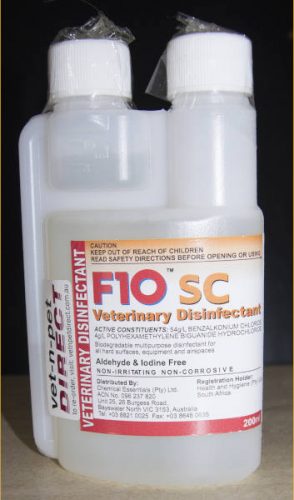
Neopredisan works well as a disinfectant for reptiles (Eckert cited in Pasmans et al, 2008). Neopredisan is effective on cryptosporidia, coccidia, bacteria, fungi, viruses and more (Neopredisan).
To clean a bearded dragons cage effectively with disinfectant, mix with water using the recommended ratio. Alternatively the disinfectant can be mixed into a spray bottle and sprayed on the bearded dragons cage and accessories. Leave the surfaces wet with the disinfectant mix for the specified time (see the instructions) and then wipe off drying the areas.
2. Bleach
Another disinfectant that may be used to clean bearded dragons house is bleach. Bleach can be used at a strength of 50 mL to 1 L of water (5% solution sodium hypochlorite) (Divers and Mader, 2005; Pasmans et al, 2008). When using household bleach the solution must be in contact with the surfaces for between 10 to 60 minutes (Geneva: World Health Organization, 2014). Once the time is up, rinse off thoroughly.
Bleach is ineffective when organic material is present so ensure the cleaning was thorough prior to applying.
Bleach is corrosive and will damage metal and paint. Ensure it is washed thoroughly off all surfaces.
The fumes are toxic and can be overwhelming. Ensure neither yourself or the animals breathe in the fumes. Full strength bleach has been associated with death of birds and reptiles in their cages (Divers and Mader, 2005).
The chlorine in bleach can be deactivated by using a dechlorinator or exposing to direct sunlight for a few hours (Divers and Mader, 2005). Note that full strength bleach lets off a toxic gas in sunlight (Geneva: World Health Organization, 2014).
Bleach is a cheap cleaner and can be used against a number of threats with some notable exceptions such as coccidia (Divers and Mader, 2005). The post on how to clean for coccidia goes through the best ways to clean for this potentially deadly disease.
Warning, do not mix bleach with other chemicals, this is extremely dangerous or may simply reduce its effectiveness (Geneva: World Health Organization, 2014).
3. Ammonia
A 5% ammonia solution kills coccidia and Cryptosporidium (Divers and Mader, 2005; Pasmans et al, 2008) although a 10% solution is recommended generally for coccidia. Cryptosporidium oocysts become ineffective after 18 hours of contact over at least 3 days and a further 3 days left to dry (Cranfield et al, 1999).
4. Cleaning Bearded Dragons House with Vinegar
Can I use vinegar on my bearded dragons house? Using vinegar to clean your bearded dragons house is not as effective as chemical disinfectants (Johnston and Gaas, 2006). However, it can be useful for removing mineral deposits.
5. Heat and Steam to Clean Bearded Dragons Cage
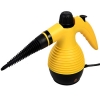
Can I use steam to clean my bearded dragons house? Steam can be used to clean bearded dragons house to control pathogens and parasites. Steam is clearly chemical free and useful for controlling coccidia and mites, and some other difficult to eradicate pathogens and parasites.
Heating to 45-60°C for between 5-9 minutes and temperatures above 52°C inactivates Cryptosporidia oocysts (Cranfield et al, 1999). An oven may be used for suitable accessories monitoring them for safety.
External parasites can be killed using Frontline or similar solutions (Pasmans et al, 2008). Snake mites die in temperatures below 5°C or over 45°C and humidity above 20%.
Steam cleaning is highly effective when done in a methodical and very slow manner. Move the wand horizontally going from the top down covering every inch of space. The steam should not bound back up on areas already cleaned to reduce anything becoming airborne recontaminated already cleaned areas. Repeating the action twice will assist in covering all areas.
When steam cleaning your bearded dragons house ensure the wand stays close to, almost touching, the surface to get maximum temperature.
Warning on Fragrances
Fragrances put a more appealing scent over more offensive odours. Cleaning products with appealing fragrances are great marketing but do not clean, they simply add more chemicals to the cleaning product. Fragrances in air fresheners and cleaning products use phthalates to carry the scent and have been linked to multiple health issues from headaches to reproductive problems and even cancer (California Childcare Health Program, 2013). Unfortunately purchasing unscented products does not make them hazard free either (California Childcare Health Program, 2013).
Don’t use air fresheners. “Air fresheners are particularly concentrated sources of fragrances that are full of toxic chemicals.” (California Childcare Health Program, 2013).
Cleaning the Glass Inside of Bearded Dragons House
Clean the inside of the glass of your bearded dragons house using a microfiber cloth with water. The microfiber cloth will clean and remove streaks (California Childcare Health Program, 2013). If the glass is soiled, wash it with water first then use a window wiper. Finish it off with a microfiber cloth. Now that is environmentally friendly!
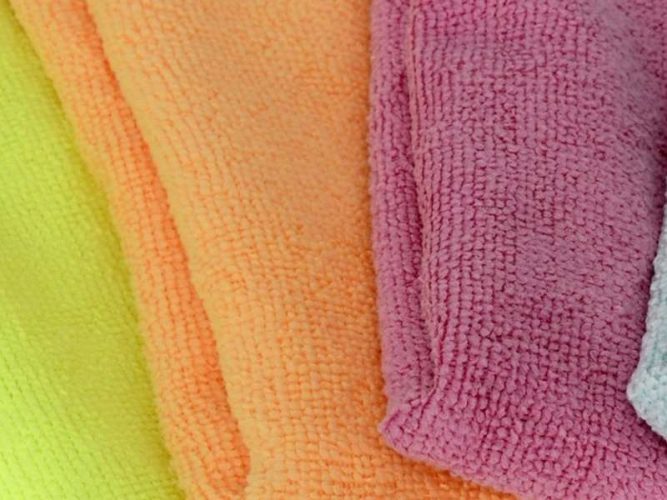
What to Clean Bearded Dragons House With
The best equipment to clean a bearded dragons house and furnishings are:
- Chemical resistant gloves
- Spray bottles for cleaning and disinfectant solution
- Paper towels to clean up spills
- Window wiper
- Microfiber – one cloth for cleaning and one for polishing glass
- Bucket for disinfectant solution
- Handheld steam cleaner (useful optional equipment)
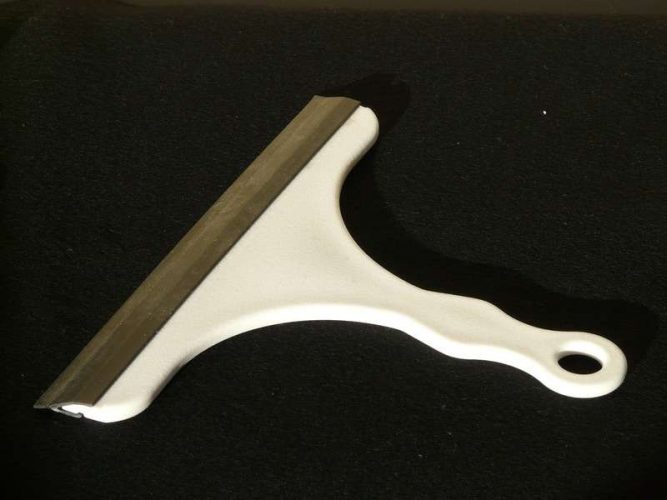
Benefits of Microfiber Cloths
Microfiber cloths are extraordinarily good at removing large number of microbes and can absorb seven times its own weight in water (California Childcare Health Program, 2013). Microfiber cloths can get into cracks that other cloths can’t due to its make up of tiny split fibers. The fibers generate a static electric charge as it is wiped across objects and surfaces that attracts dust and particles (Field Research and Consultation Group, 2011).
Microfiber cloths have been shown to have a significant impact on reducing bacteria left behind (Field Research and Consultation Group, 2011).
Clean microfiber cloths separately to all other laundry. Their ability to attract dirt and other undesirables is also effective in the wash so its effectiveness would be reduced (California Childcare Health Program, 2013). Clean the cloths using hot water and detergent. Do not use bleach on the microfiber clothes, this shortens their life (California Childcare Health Program, 2013).
Cleaning Equipment not to Use
- Cotton cloths do not capture germs well and can spread germs (California Childcare Health Program, 2013).
- Sponges are hard to clean and can grow bacteria (California Childcare Health Program, 2013).
5 steps to clean for Salmonella
5 steps to clean for salmonella are:
- Clean everything with soapy water to remove debris.
- Boil rocks for 30 minutes.
- Heat branches in an oven at 200-250°C (392-482°F) for 30 minutes.
- Replace the sand or heat in the oven 200-250°C (392-482°F) for 30 minutes.
- Wash your clothes separately to other clothes.
(AVMA, 2009)
To learn more about salmonella see can my bearded dragon make me sick by Dr Emecheta.
How often do you need to clean a bearded dragon tank?
Daily light clean removing poop, uneaten food and spot cleaning. Weekly detailed clean to control odors, disinfecting to keep pathogen levels down, clean the glass inside the tank to make it sparkle and sprucing everything up.
How can I make my bearded dragon smell better?
You can make your bearded dragon smell better by providing a warm bath and gentle rub with a toothbrush, removing stools and dead insects (like crickets) from the enclosure quickly, if a loose substrate or reptile carpets are being used consider changing it, thorough clean of the tank weekly and getting a vet check for health (especially if there are smelly stools).
References
- California Childcare Health Program. (2013) UCSF School of Nursing. Green Cleaning, Sanitizing, and Disinfecting: A Toolkit for Early Care and Education.
- CDC (2008) Introduction, Methods, Definition of Terms. Guideline for Disinfection and Sterilization in Healthcare Facilities. Accessed July 2019.
- Cranfield, M.R., Graczyk, T., Wright, K., Frye, F.L., Raphael, B., & Garner, M. (1999) Cryptosporidiosis. Bulletin of the Association of Reptilian and Amphibian Veterinarians 9, 15–24.
- Department of Health. Government of Western Australia. Cleaning and sanitising food premises and food equipment. Accessed July 2019.
- Divers, S. J., and Mader, D. R. (2005) Reptile Medicine and Surgery E-Book. Elsevier Health Sciences.
- Geneva: World Health Organization (2014) Infection Prevention and Control of Epidemic- and Pandemic-Prone Acute Respiratory Infections in Health Care. Annex G, Use of disinfectants: alcohol and bleach.
- Johnston, C.S. and Gaas, C.A. (2006) Vinegar: Medicinal Uses and Antiglycemic Effect. 8(2): 61.
- Pasmans, F., Blahak, S., Martel A., and Pantchev, N. (2008) Introducing reptiles into a captive collection: The role of the veterinarian. The Veterinary Journal. Vol 175: 53–68.
- Veerabadran, S., and Parkinson, I. M. (2010) Cleaning, disinfection and sterilization of equipment. Anaesthesia & Intensive Care Medicine. Vol 11(11): 451-454.
- Field Research and Consultation Group. (2011) Microfiber. Department of Environmental and Occupational Health Sciences. University of Washington.
- NEOPREDISAN Menno
Do you have any tips and tricks on cleaning your bearded dragons cage to share with the community?


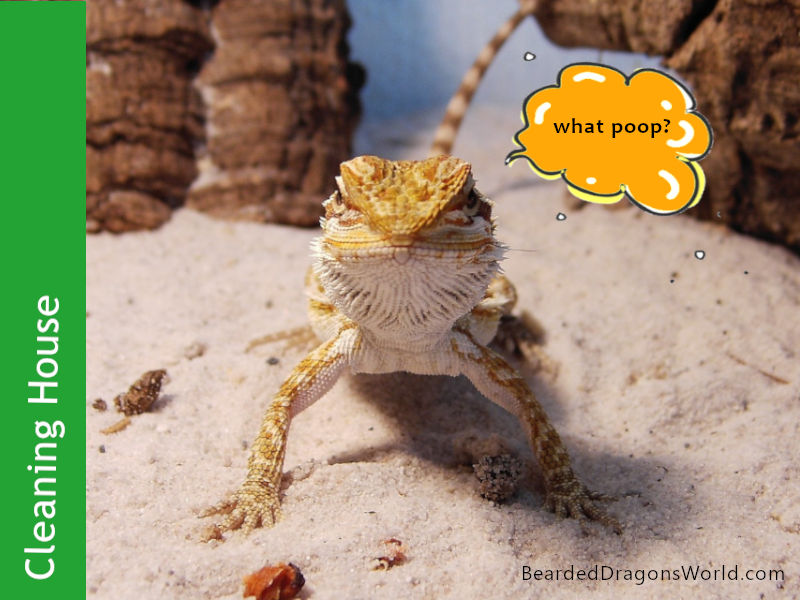

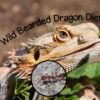


Is there a way you can you tell if bulging eye is from: shedding, Vitamin A overdose, parasites or something else? How long is too long to have a bulging eye?
Eye bulging is quick movement, not something that stays bulged. If the eyes are remaining bulged it would be best to call the vets.
Nice Post
Thank you very much Shane!